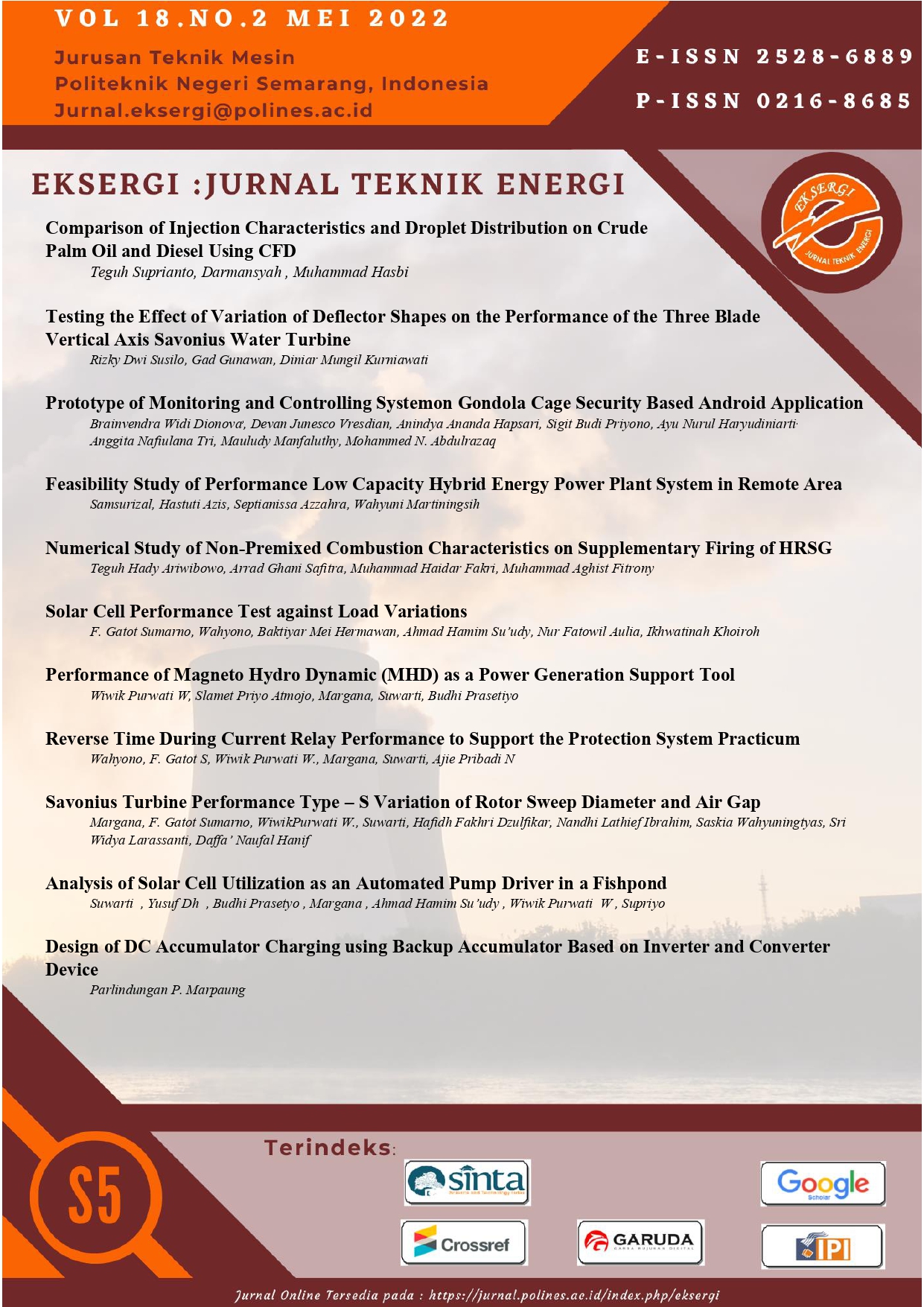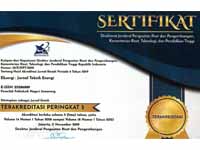Performance of Magneto Hydro Dynamic (MHD) as a Power Generation Support Tool
DOI:
https://doi.org/10.32497/eksergi.v18i2.3571Keywords:
Magneto Hydro Dynamic, Power generation.Abstract
Magnetohydrodynamics is a method for generating electricity by utilizing the interaction between a magnetic field and an electrolyte fluid. MHD components: salt water electrolyte, Neodymium N52 magnet, and Cu-Zn electrode. The MHD used is a coarse salt water electrolyte. The purpose of the MHD model is as an innovative technological breakthrough that is used to support increasing the efficiency of the power generation system. The lowest efficiency is shown in the second data with variations in salt content of the 5 grams/liter experiment without MHD support, which is 0.08%. The highest efficiency is shown in the twentieth data with variations in salt content of the 95 gram/liter experiment supported by MHD, which is 0.59%. The maximum efficiency increase that can be achieved is 0.37% with variations in salt content of 60 grams/liter.
References
Alkasasbeh, Hamzah T.S, Numerical Solution for Convective
Boundary Layer Flow Over A. Solid Sphere Of Newtonion and NonNewtonion Fluid. University Malaysia Pahang, 2015
B.Widodo, Anggriani,I, Khalimah,D.A, Zainal F.D.S, Imron.C,
Unsteady Boundary Layer Magnetohydrodinamics in Micropolar
Fluid Past a Sphere Far East Journal of Mathematical Sciences
(FJMS), Vol 100, No.2, 291-299, 2016
B.Widodo, C.Imron,and R.Sahaya, Aliran Fluida
Magnetohydrodynamics Viscoelastis Tersuspensi yang Melewati Plat
Datar, J.Sains dan Seni ITS, Vol 5, no.2, 2016
Cui,W.,Ou, Y dan Ren, D. Incompresible limit of full compresible
magnetohydrodynamic equation with well-prepared data in 3-D
bounded domains. Journal of Mathematical Analysis and Aplication
263-288, 2015
Gomes, D., Martin, LN dan Dmitruk, P. Magnetohydrodinamics in
solar and apace physics. Advances in space reseach 51. 1916-1923,
Ikfina. “Pembuatan Elektroda Dan Perancangan Sistem Capacitive
Deionization Untuk Mengurangi Kadar Garam Pada Larutan Sodium
Clorida (NaCl)”. Berkala Fisika, 16(3):67-74, 2013.
Kasim,Abdul Rahman.M, Convective Boundary Layer Flow of
Viscoelastic Fluid, Univercity Teknology Malaysia, 2014
Krishnan & Jinshah, 2013 photovoltaic generation system
(photovoltaic solar cells), electrochemical energi conversion (fuel
cells), magneto hydro dynamic generation (MHD),
electrogasdynamic generation (EGD), dan thermoelectric power
generation
Lewis, Laura H. “Fundamentals of Magnetism & Magnetic
Materials”. Boston MA : Northeastern University, 2015
Moranian. Filtrasi Jeruk Nipis Yang Ditambah NaCl + Na EDTA
Sebagai Elektrolit Baterai Dengan Charger Cell, 2015
Pauzi, dkk. Analisis Kelistrikan Sel Volta Memanfaatkan Logam
Bekas: Universitas Lampung, 2015
Rachmadona, Nova dan Nyayu Aisyah. “Teknologi Pemanfaatan
Batubara Magneto Hidro Dinamik (MHD)”. Teknik Kimia.
Palembang : Politeknik Negeri Sriwijaya, 2014
Rina Sahaya dkk, “Aliran Fluida Magnetohidrodinamik Viskoelastis
Tersuspensi yang Melewati Pelat Datar”. Surabaya, 2016
Siti. “Sea Cell (Sea Water Electrochemical Cell) Pemanfaatan
Elektrolit Air Laut Menjadi Cadangan Sumber Energi Listrik
Terbarukan Sebagai Penerangan Pada Sampan”. Jurnal Sain Dan
Teknologi, 10(1), 2015
Zaenab Siti, dkk.. “Analisis Pembangkit Elektrik Menggunakan
Media Air Garam Sebagai Larutan Elektrolit”. Universitas Telkom,
Downloads
Published
Issue
Section
License
Authors who publish with this journal agree to the following terms:Authors retain copyright and grant the journal right of first publication with the work simultaneously licensed under a Creative Commons Attribution License that allows others to share the work with an acknowledgement of the work's authorship and initial publication in this journal.
Authors are able to enter into separate, additional contractual arrangements for the non-exclusive distribution of the journal's published version of the work (e.g., post it to an institutional repository or publish it in a book), with an acknowledgement of its initial publication in this journal.
Authors are permitted and encouraged to post their work online (e.g., in institutional repositories or on their website) prior to and during the submission process, as it can lead to productive exchanges, as well as earlier and greater citation of published work (See The Effect of Open Access).







